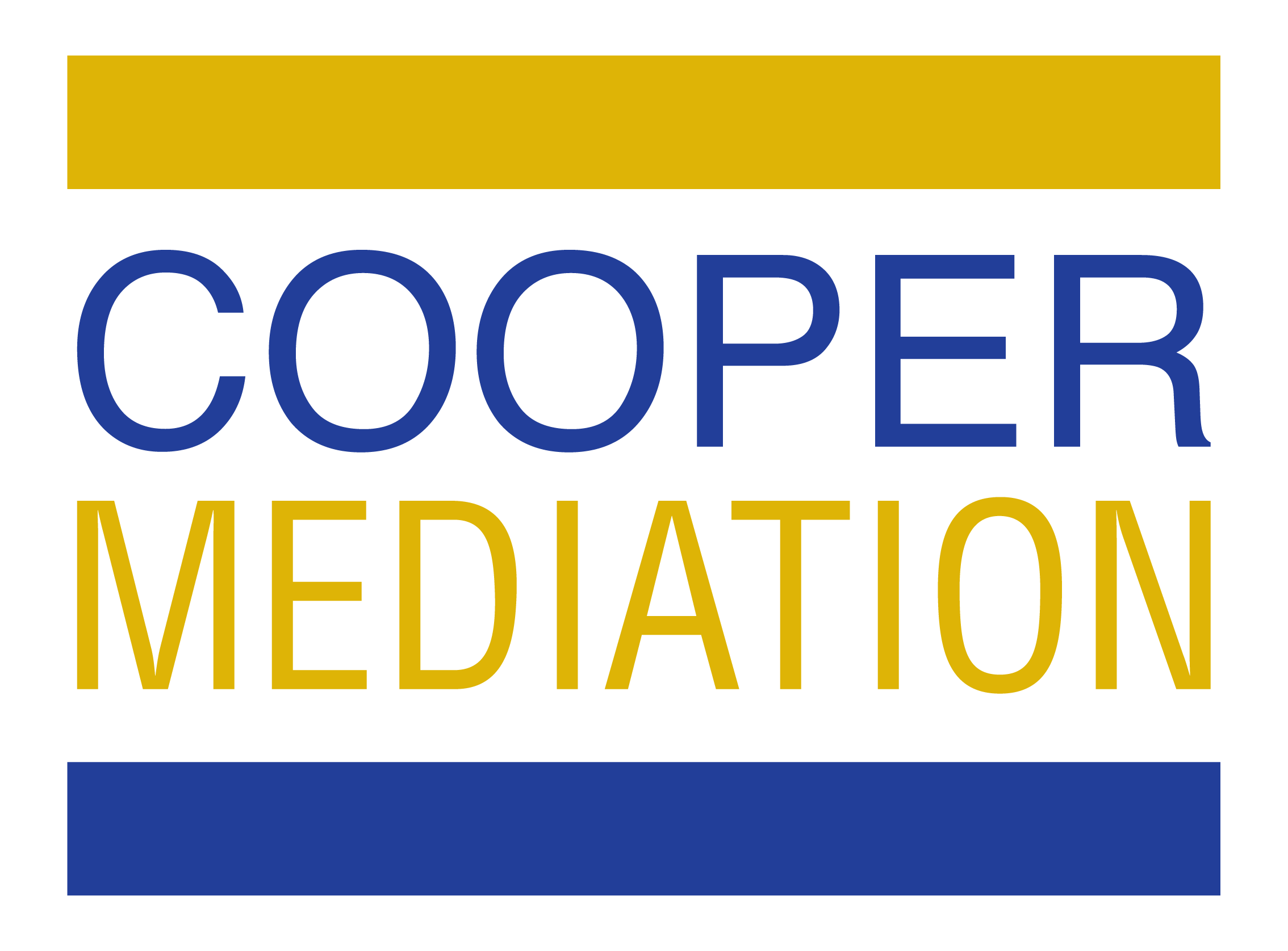
08 Dec CMI Mediator Logan Cooper Reflects On Five Lessons Learned Over Five Years Of Conducting Mediations
You’ve heard that time flies when you’re having fun. Well, time also apparently flies when you’re facilitating meaningful discussions that bring parties in conflict together with the aim of finding a mutually agreeable resolution. Granted, it doesn’t roll off the tongue quite as easily.
It’s hard for me to believe it, but I’m celebrating five years as a mediator at Cooper Mediation Inc. (CMI). During the past half-decade, I’ve conducted more than 300 mediations. Each time I enter the room (or start the virtual meeting), I bring the knowledge and experience I’ve gained from every previous mediation with me. However, one of the joys of this type of work is knowing that there will always be additional lessons to learn, new or different ways to further refine my skills, and new tools to add to my mediator toolbox.
In this blog post, I’d like to look back to share five lessons learned over my first five years, and look ahead by setting my goals for the next five years.
Lesson #1 – The Mediation Medium May Change But The Goal Remains The Same
Aside from the Simpsons, who could have predicted a pandemic? One microscopic virus forced dramatic change in this industry and that came with a significant amount of growing pains. Once the pain subsided, the growing pains served as a reminder that mediation is, and should, be constantly evolving.
While the idea that there could be a period of time when I couldn’t meet any clients in person was not on my radar (or probably anyone else’s) five years ago, CMI managed to meet the challenges posed by the COVID-19 pandemic with great success.
Thankfully, technological advances allowing for video-conferencing were available to us when the world seemed to temporarily stand still. Although virtual mediations were new to me and my colleagues, we soon learned that while the medium for discussions may have changed, the tried and tested process for facilitating a mediation hadn’t.
Nevertheless, as my colleague Jon Cooper noted in this blog post, we did learn that there were some elements of in-person mediations that did not translate easily to virtual meetings. Gauging body language proved more challenging, having uninterrupted discussions was not always possible when there were technical issues (or when people unintentionally walked into the room where a participant had set up their computer), and there was a steep learning curve for some participants who were using the technology for the first time. However, avoiding commutes to in-person mediations was certainly a bonus for many people.
While the goal of the mediation process remains the same (to help guide parties towards informed negotiation and self-determination), the sudden shift to virtual mediations was a good reminder that I must always think of ways to improve the process to better serve my clients. Currently, I’m focussed on improving my virtual communication skills, using technology as an assistive tool, and continuing to look for ways that I can grow, modify and evolve my practice.
Lesson #2 – Relationships Matter
The insurance industry and personal injury bar are relatively small communities where the same legal team and insurance reps negotiate different cases. While individual plaintiffs and defendants may never encounter each other again after a mediation, other participants almost certainly will.
What does this mean? Essentially, burning bridges is never advisable. It’s important to think long-term, create win-win situations, and establish professional relationships built on respect and trust.
Knowing that you will likely be at mediations with some of the same people in the room again should also encourage you to observe their interpersonal skills, negotiating style, and how they approach matters. This information can be hugely beneficial when planning strategy.
I often look at the insurance industry and personal injury bar as an ecosystem populated by symbiotic relationships. While my opportunities to mediate are generated by disagreement, I think that we need to try not to be disagreeable. It’s important to keep our relationships with each other a top priority, considering we all need each other to keep our ecosystem afloat.
Lesson #3: Put on Your Own Oxygen Mask Before Assisting Those Around You
Conflict can bring out the worst in people. Sometimes at mediation, people can get angry or dismissive. Sometimes, people raise their voice. Sometimes, people metaphorically shoot the messenger.
As a mediator, I study the art and science of persuasion. Despite my best efforts, I can not control what people do and say. I can, however, control how I react to these situations. In order to increase my chances of reacting in a productive way, I try to take care of myself by being well-rounded, well-rested and well-prepared.
I find time to do the things that shape my identity outside of work – making music, creating art and seeing family and friends. I do my best to ensure I enter each mediation energized and ready to be productive. I expand my subject matter knowledge by reading case law and recent decisions. When faced with new problems, I lean on my colleagues for guidance and assistance. I respect and value people’s criticism of me but I will weigh it according to how much I respect and value the source of the criticism. I try to find silver linings and moments of humour in otherwise challenging situations.
We can best help others by first helping ourselves. When you are ready to put your best foot forward, other people can feel confident following the path you take.
Lesson # 4 – Using Body Language To Help Seal The Deal
Experts suggest verbal information (words) account for only about seven per cent of our understanding in interpersonal communication. The tone of what’s said provides 38 per cent of the information we need to decode a situation. A full 55 per cent of our understanding usually comes from observing a person’s body language.
While some body talk comes across loud and clear (walking away from talks or shaking our heads in disagreement), other non-verbal signals can be subtle. Moreover, subconsciously, our actions may unintentionally tip our hand and reveal what we’re thinking (whether or not we realize what we’re thinking). As I noted in this blog post, understanding body language can make communicating your own message easier and help you to decode not only what an opposing party is trying to say, but also what they may be thinking or feeling.
As a mediator, I’ve tried to hone my own body language reading skills and I have become more cognizant of what I may be revealing with my own physical actions. When words alone are not enough, think about other ways to get your message across.
For example, never underestimate the power of a smile. Scientists have proven that smiling is contagious. Not only is the physicality of a smile contagious, but the presence of a smile can, in turn, affect how a person feels internally. In the face of disagreement and contention, I try to turn my frown upside down – It helps keep my optimism alive and positively influences those around me.
Lesson #5 – Settling Is Important, But Not Everything
The term “failed mediation” should be banished from our minds and vocabulary. While some people may consider a mediation a success only if it results in a mutually agreeable settlement, you should be open to seeing other “wins” even if the matter doesn’t resolve by the time the buzzer sounds.
Every mediation is an opportunity to learn, whether or not settlement is achieved. Unless one of the parties fails to show up, you will walk away from any mediation gaining some valuable information.
First, you should get a better sense of the strengths and weaknesses of your case as you discuss it before a neutral third party. Second, you may be able to determine some areas of alignment with the other parties in order to reduce the number of unresolved issues. Third, you may learn there is a potential zone of agreement even if you can’t finalize a deal by the mediation’s conclusion. Fourth, in preparing for the mediation, parties will likely exchange additional information, reports and records that could help you decide whether your pre-existing assumptions about the case need to be reassessed. Finally, whether in-person or virtually, a mediation could be the first time all parties are able to meet and talk to each other. By observing other participants and their reactions, you can glean valuable information to help you make your case at future mediations or at trial.
I wholeheartedly believe in the benefits of mediation. That said, I do not forget that we have courtrooms, judges and juries for a reason. Government statistics suggest 98 percent of civil suits never make it to court. The reasons are broad – some plaintiffs will decide to stop pursuing their claim, lawsuits may be dismissed at an early stage of litigation and people reach resolutions at mediation or through informal settlement discussions. That said, I don’t sell settlements; I sell informed decision-making. As a mediator, I am committed to making sure that is what decision makers do.
Sometimes, cases don’t resolve. It’s in these mediations, and the attendant impasses then present, that I remind myself of the 2 percent of lawsuits that may need to go the full distance to a judgment or a verdict. More likely is the fact of timing – it may be that the mediation occurred at an inopportune time.
Looking Ahead
I’m a mediator, not a prognosticator. While I can’t be certain what the future will hold for my practice, my focus will always remain on giving my clients what they need to have a productive mediation – whatever the ultimate outcome. Drawing on what I’ve learned in the past five years, I’m more confident than ever in my ability to do just that.
About The Author
 Logan Cooper joined the Cooper Mediation team in November 2017 and devotes 100% of her professional time to mediating at roster-rates. She has mediated over 150 cases in the areas of personal injury, property damage, long-term disability and other insurance-related disputes. She has handled global mediations, cases with multiple parties, self-represented litigants and cases with complicated technical and interpersonal challenges.
Logan Cooper joined the Cooper Mediation team in November 2017 and devotes 100% of her professional time to mediating at roster-rates. She has mediated over 150 cases in the areas of personal injury, property damage, long-term disability and other insurance-related disputes. She has handled global mediations, cases with multiple parties, self-represented litigants and cases with complicated technical and interpersonal challenges.
Logan can be reached at logan@coopermediation.ca or (416) 726-1344.
To schedule a mediation with Logan, visit: https://coopermediation.ca/logan-cooper-online-calendar/.
